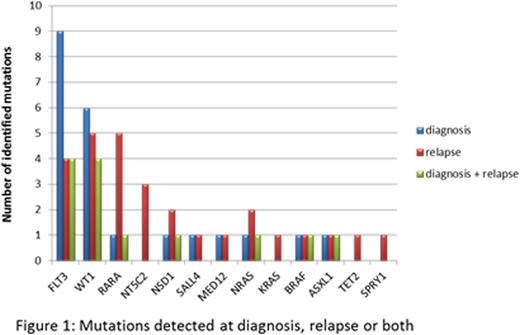Abstract
Background: APL is, in the vast majority of cases, driven by t(15 ;17) translocation, which leads to PML/RARA rearrangement. Remarkably, APL is an uncommon genetically simple disease and only few additional alterations, cooperating with PML/RAR, have been described at diagnostic (Welch et al, Cell 2012). Most APL can be cured with targeted therapy combining all-trans retinoic acid (ATRA) and chemotherapy (CT). However, genetic mechanisms underlying the 10-15% relapses observed with this regimen remain unclear. The goal of the present study was to identify mutations that cooperate with PML/RAR and those responsible for acquired resistance to ATRA-CT treatment in APL patients by whole-exome sequencing of diagnostic/ remission/relapse trios.
Methods:Newly diagnosed APL patients included in clinical trials of the French Swiss Belgian APL group between 1994 and 2008, treated with ATRA-CT, before the introduction of first-line ATO, who experienced at least one relapse and had adequate material, were studied. We collected retrospectively 64 samples from 23 patients, including 23 diagnostic samples, 18 at first complete remission (CR) and 23 at relapse (22 first relapse and 1 second relapse). Whole exome-sequencing was performed on all samples. DNA libraries were prepared with the SureSelect human v5 kit (Agilent) and sequenced on Hiseq1000 (Illumina). The bioinformatic analysis was performed by GECO/integragen using CASAVA variant calling (Illumina) and dedicated pipeline. 18 trios and 5 duos passed the stringent quality control and were analyzed for somatic variants and copy number variations (CNV).
Results :After elimination of polymorphisms, the median number of somatic variants corresponding to de novo mutation at diagnosis was 14, while only 3 new somatic variants appeared at relapse (figure 1). Notably, we failed to detect oncogene alterations other than PML/RARA in 7/23 (30%) patients. At diagnostic, 39% of patients (9/23) presented the common FLT3 alterations and at relapse 22% (5/23) of patients presented the known RARA mutations. Moreover, recurrent alterations were observed in activators of the MAPK signaling (22%): NRAS (2 patients), BRAF (1 patient), KRAS (1 patient), SPRY1 (1 patient). Mutations in the NT5C2 gene (3 patients), coding a 5'nucleotidase implicated in resistance to nucleoside-analog therapy, were solely observed at relapse, as in acute lymphoblastic leukemia (ALL). Abnormalities of epigenetic regulators were also detected at diagnostic and/or relapse: WT1 (7 patients, 30%), NSD1 (2 patients), TET2 (1 patient), ASXL1 (1 patient) and MED12 (2 patients). Homozygote WT1 inactivation by mutation plus neutral copy LOH occurred in 3 patients at relapse.
The genetic markers identified allowed us to construct several evolution models. In 8 patients (35%), the diagnostic and relapse clones were clearly distinct, supporting the fact that they independently derived from pre-leukemic cells that survived ATRA/chemotherapy. In contrast, other relapses appeared to derive from the diagnostic clone.
Conclusion:Our data highlight the genetic simplicity of APL with very few alterations detected and 30% patients without identified mutations in addition to PML/RARa. Our results support the existence of two prototypic mechanisms of relapse: re-emergence of a new APL from persisting pre-leukemic cells and relapse from APLs often expressing strong oncogenes at diagnosis, impeding therapy response and favoring the acquisition of resistance mutations at relapse, including PML/RARA or NT5C2. It will be interesting to assess the prevalence of those two mechanisms in the exceptional cases of relapse in patients treated with more recent frontline regimens that combine ATRA and arsenic in APL.
Ades:Celgene, Takeda, Novartis, Astex: Consultancy, Honoraria, Membership on an entity's Board of Directors or advisory committees, Research Funding. Fenaux:Celgene, Janssen,Novartis, Astex, Teva: Honoraria, Research Funding.
Author notes
Asterisk with author names denotes non-ASH members.


